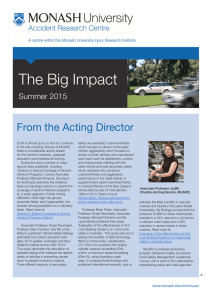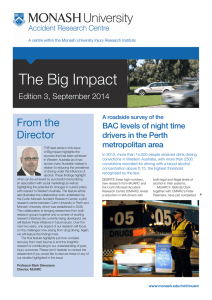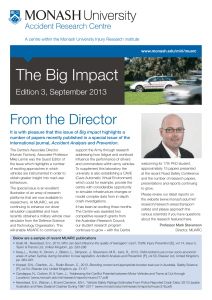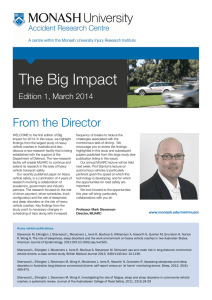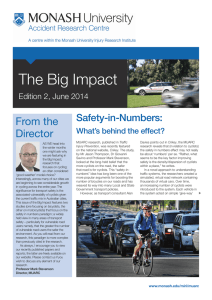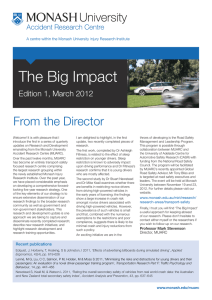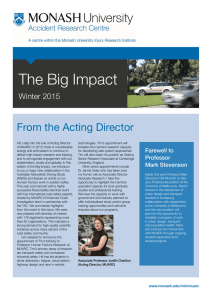The Big Impact From the Director Edition 4, December 2014
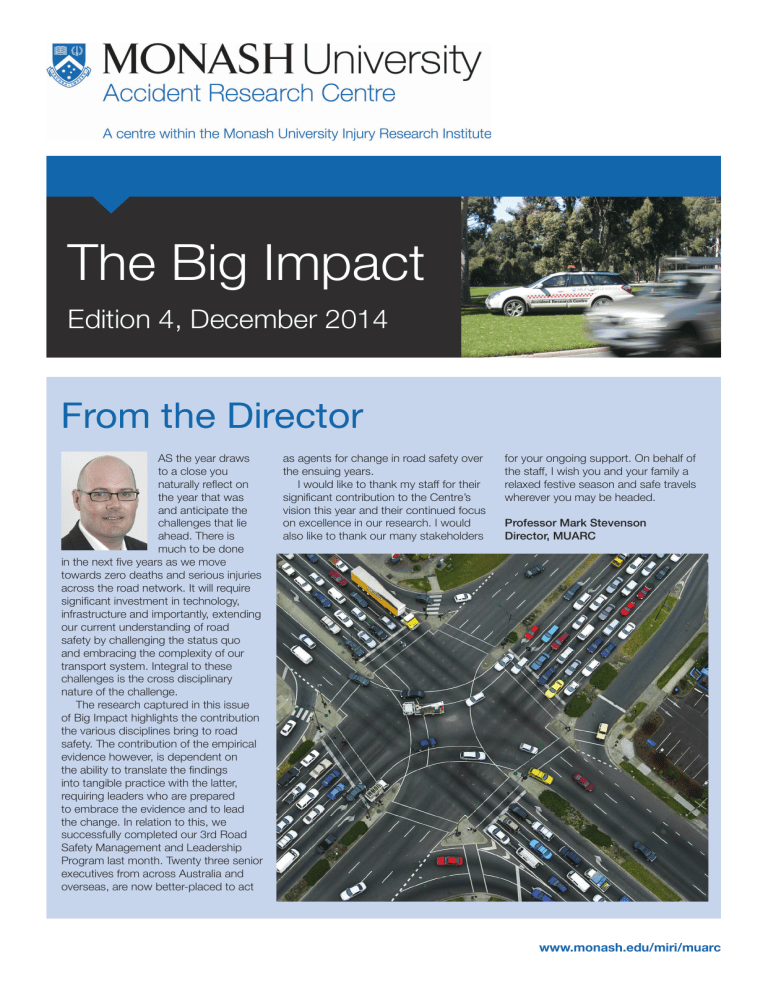
The Big Impact
Edition 4, December 2014
From the Director
AS the year draws to a close you naturally reflect on the year that was and anticipate the challenges that lie ahead. There is much to be done in the next five years as we move towards zero deaths and serious injuries across the road network. It will require significant investment in technology, infrastructure and importantly, extending our current understanding of road safety by challenging the status quo and embracing the complexity of our transport system. Integral to these challenges is the cross disciplinary nature of the challenge.
The research captured in this issue of Big Impact highlights the contribution the various disciplines bring to road safety. The contribution of the empirical evidence however, is dependent on the ability to translate the findings into tangible practice with the latter, requiring leaders who are prepared to embrace the evidence and to lead the change. In relation to this, we successfully completed our 3rd Road
Safety Management and Leadership
Program last month. Twenty three senior executives from across Australia and overseas, are now better-placed to act as agents for change in road safety over the ensuing years.
I would like to thank my staff for their significant contribution to the Centre’s vision this year and their continued focus on excellence in our research. I would also like to thank our many stakeholders for your ongoing support. On behalf of the staff, I wish you and your family a relaxed festive season and safe travels wherever you may be headed.
Professor Mark Stevenson
Director, MUARC
www.monash.edu/miri/muarc
Monash Study links piece rate payment to truck drivers increased risk of fatigue
Driver fatigue and sleepiness is considered to contribute up to 40% of truck crashes. A new study - from the
Monash University Accident Research Centre (MUARC) published in November in the journal, Traffic Injury
Prevention – shows that performance-based per-kilometre or per-trip “piece-rate” payments encourage drivers to keep driving at the expense of sleep and rest breaks, maintenance or safety checks. The report –the first to link piece rate payments with fatigue and increased risk of accidents – also reveals a link between piece rate payments and amphetamine use.
THE Australian heavy vehicle industry employs close to 200,000 people and has a turnover of over $50billion.
Whilst accounting for less than 3% of
Australia’s total vehicle fleet, incidents involving articulated and heavy-rigid trucks contribute to 16% of total road fatalities highlighting the elevated risk associated with heavy vehicle driving as an occupation. The overrepresentation of heavy vehicles among road fatalities brings with it public calls for stronger industry regulation or operational standards designed to improve safety.
The study –– was presented by
Professor Mark Stevenson, Director of MUARC, at the Association for the
Advancement for Automotive Medicine conference in Munich in October and because the study looked at over 340 truck drivers randomly in WA and NSW – it is also the first study to give an indication of the prevalence of piece rate work in the heavy vehicle industry.
According to co-author, Dr Jason
Thompson, the new evidence raises concerns over the current preference for owner-drivers, trucking companies and industry bodies who have “shown preference for more flexible, deregulated environments, which place responsibility for safety back on individual companies and drivers”, he said.
“Despite the evidence of the role of piece-rate payment in driver fatigue, the conflict between payments and safety is often challenged by industry groups.
Transport unions have generally advocated additional system regulation to ensure safety standards are met or maintained.”
The MUARC study looked at the association between compensation methods for drivers, fatigue-related driving behaviours and sleepiness among
Australian heavy vehicle drivers.
The researchers examined data from a random sample of 346 heavy vehicle drivers who had not been involved in a crash. A 40-minute interview was conducted regarding driver demographics, truck characteristics, and compensation arrangements. Specific details about drivers’ behaviour on their most recent trip including load(s) carried, distances driven, hours driven, rest breaks, and hours of sleep on the previous night were taken.
The interview also included standardised validated questionnaires including the
Epworth Sleepiness Scale (ESS).
The study revealed that piece-rate compensation methods were associated with higher-levels of fatigue-related driving than non-piece rate methods. Followup analysis also revealed higher use of caffeine and amphetamines among piecerate drivers for the purpose of staying awake while driving. The study also found that driving behaviours encouraged by perkm and per-trip compensation methods may manifest as:
• increased distances driven per day
• reduced driver rest breaks
• longer periods of driving without a break
• increased overall working hours per week
• compromised rest-breaks
• reduced sleeping hours
• increased requirement to consume stimulants in order to stave off sleep while driving
• increased drowsiness
• higher likelihood of driving while fatigued
According to Professor Stevenson,
“particularly concerning in these results was the tendency for drivers on per-trip and per-km rates to drive longer average durations without taking a break.” Drivers of a piece rate payment system operated on average of 5.3 hours of driving between breaks – this compared to per-km and per-trip drivers operated for an average of 5.3 and 4.8 hours between breaks, respectively - considerably higher than fixed rate drivers (4.3 hours). “These results were compounded by the increased likelihood of per-trip and perkm drivers to be carrying ‘time critical’ loads, the increased tendency to report having slept in their trucks on the night prior to interview, and increased likelihood of reporting consumption of caffeine and amphetamines for the purposes of staying awake while driving in the past month. Further, where differences between drivers operating under per-km or pertrip piece-rate compensation methods were observed, drivers under per-km methods tended to show the highest levels of fatigue-related driving,” the authors reported.
2 www.monash.edu/miri/muarc
Autonomous emergency braking in motorbikes could save lives:
An international study
Motorcycles are the most rapidly growing form of transport globally, with the number of motorcycles in
Australia increasing by 56% over the past decade alone. This has meant an increase in the number of motorcycle crashes resulting in injury. Importantly, as opposed to cars, the trends of crashes and fatalities among riders show little sign of declining.
AN international review of motorcycle crashes has looked at whether autonomous emergency braking (AEB) could have mitigated the severity of injury as an indicator of whether the safety measure should be offered to motorcycle owners in the same way it is currently being offered to new car owners.
Autonomous emergency braking is currently available in new Australian cars as a safety option, however according to the Australian New Car Assessment
Program, the installation of AEBs in all cars on the road would results in saving 250 lives each year and reduce the financial cost of the national road toll by $5 billion annually.
Autonomous emergency braking for motorcycles was developed in 2006 but is not available commercially, largely because of the lack of data as to whether it actually makes motorcycle riding safer.
Researchers at the Monash University
Accident Research Centre (MUARC), working with colleagues from NSW,
Sweden and Italy have studied in-crash data over 200 motorcycle crashes across the three countries. The data – the first to evaluate AEBs over a broad range of motorcycle crash scenarios – was presented at the Association for the
Advancement for Automotive Medicine conference in Munich in October by
MUARC’s Dr Giovanni Savino.
AEBs on motorcycles can detect an obstacle through sensors in the front of the motorcycle, braking automatically – leading to deceleration even if the rider doesn’t react. According to Dr Savino, optimal braking is possible only when the rider applies some braking. “When the rider does not react, only mild deceleration is applied by the system to avoid destabilisation of the rider,” he said.
The study looked at in-depth crash data from:
• 80 hospital-admittance cases collected during 2012-2013 within a three hour driving range of Sydney;
• 40 serious crashes in the metro area of
Florence during 2009-12
• 92 fatal crashes that occurred in
Sweden from 2008-9
Each crash was extensively reviewed, involving reviewing of reports from police, crash investigators, hospitals as well as reconstructions of each accident.
The study found that – had the AEBs been fitted to the motorcycles in the accidents reviewed – average speed at impact would have been reduced close to
5%. Importantly the AEBs would have addressed a third of the crashes with an average slowing of the motorcycle by 3.5 km/hr at impact. In particular the addition of an AEB would have had a significant effect on the number of fall events prior to impact.
www.monash.edu/miri/muarc 3
MUARC hosts the internationally renowned
Road Safety Management and Leadership Program
Now in its third year, MUARC in association with the University of
Adelaide’s Centre for Automotive
Safety Research and the Melbourne
Business School hosted its Road
Safety Management Leadership
Program in Melbourne in November.
The program, which is targeted at senior executives, attracted 23 attendees including executives from
South Africa, Kenya, the Caribbean,
India and throughout Australia.
Road traffic injuries kill 1.2 million people globally each year and seriously injures up to 50 million people. Fatality rates are expected to rise by 87% by 2020 and more than
50 million deaths and 500 million serious road traffic incidents are projected over the first 50 years of this century. The week-long intensive program addresses the issue of a globally rising road toll by discussing:
• the core elements of the road safety management system
• the scientific evidence base and technological innovations underpinning effective road safety interventions and related public policy challenges
• how to introduce effective change,
• the personal qualities required to improve leadership capability, and
• how to engage with and influence internal and external stakeholders to successfully address leadership challenges.
According to Professor Mark
Stevenson, Director of MUARC, while high income countries have improved their road safety results over the last four decades, “the organisational management and leadership dimensions vital to this success have received little recognition and must be addressed, given the increasingly ambitious goals set for improved road safety performance.”
The program has become a regular fixture on the international calendar attracting candidates from a broad spectrum of sectors and organisations responsible for road safety performance (e.g. transport, justice, finance planning etc) and the related disciplines (e.g. engineering, economics, psychology, statistics, biomechanics, information technology etc) and practices (e.g. policy making, strategic planning, law enforcement, infrastructure provision and operation, traffic management etc) that support the delivery of these sectors and organisations’ safety mission and goals.
4 www.monash.edu/miri/muarc
Below are MUARC publications this quarter:
Al Nahyan, M.T., Sohal, A.S.,
Hawas, Y.E., Fildes, B. Project
Management, Infrastructure
Development and Stakeholder
Engagement: A Case Study from the UAE. Procedia Technology,
2014; 16: 988–991.
Fildes ,B., Hoque, S., Hammid, A.,
Amr, M., Jabari, O., Al-Ali, A.,
Stevenson, M. Research into
Seatbelt Wearing in the KSA.
Traffic Injury Prevention, 2014;
15(supp1): S238–S269.
Gargaro, B.A., May, T., Tonge, B.J.,
Sheppard, D.M., Bradshaw, J.L.,
Rinehart, N.J. Using the DBC-P
Hyperactivity Index to screen for ADHD in young people with autism and ADHD: a pilot study,
Research in Autism Spectrum
Disorders, 2014; 8(9): 1008-
1015.
Johnson, M., Chong, D., Carroll,
J., Katz, R., Oxley, J., Charlton,
J. Naturalistic Cycling Study:
Identifying Risk Factors for
Cyclists in the Australian Capital
Territory (MUARC Series Report
322). Report to the NRMA-ACT
Road Safety Trust. September
2014.
Johnson, M., Oxley, J.A.,
Newstead, S.V., Charlton, J.L.
Safety in numbers? Investigating
Australian driver behaviour, knowledge and attitudes towards cyclists, Accident
Analysis and Prevention, 2014;
70: 148-154.
Kuo, C., Koppel, S.N., Charlton,
J.L., Rudin-Brown, C. Computer vision and driver distraction: developing abehaviour-flagging protocol for naturalistic driving data, Accident Analysis and
Prevention, 2014; 72: 177-183.
Penumaka, A.P., Savino, G.,
Baldanzini, N., Pierini, M. Indepth investigations of PTW-car accidents caused by human errors, Safety Science, 2014; 68:
212-221.
Proske, U., Tsay, A., Allen, T.J.
Muscle thixotropy as a tool in the study of proprioception,
Experimental Brain Research,
2014; 232(11): 3397-3412.
Savino, G., Matteo, R., Brown,
J., Piantini, S., Meredith,
L., Albanese, B., Pierini,
M., Fitzharris, M.P. Further development of motorcycle autonomous emergency braking
(MAEB), what can in-depth studies tell us? A multinational study, Traffic Injury Prevention,
2014; 15: 165-172.
Senserrick, T., Boufous, S., de
Rome, L., Ivers, R., Stevenson,
M. Detailed Analysis of
Pedestrian Casualty Collisions in
Victoria, Australia, Traffic Injury
Prevention, 2014; 15(supp1):
S197-S205.
Stephan, K.L., Newstead, S.V.
Characteristics of the Road and
Surrounding Environment in metropolitan shopping strips: association with the frequency and severity of single-vehicle crashes, Safety Science, 2014;
15(supp1): 574-580.
Stephens, A., Sullman, M.J.M.
Development of a short form of the driving anger expression inventory. Accident Analysis and
Prevention, 2014; 72: 169–176.
Thompson J, Stevenson M.
Associations between payment structures, fatigue-related driving behaviour and sleepiness among heavy vehicle drivers.
Traffic Injury Prevention, 2014;
15(supp1); S10-S14.
Young, K.L., Rudin-Brown, C.,
Patten, C., Ceci, R., Lenné, M.G.
Effects of phone type on driving and eye glance behaviour while text-messaging, Safety Science,
2014; 68: 47-54.
Further information
Monash University Accident
Research Centre (MUARC)
Building 70, Clayton Campus
Monash University, VIC 3800
Telephone: +61 3 9905 4371
Email: miri-enquiry@monash.edu
